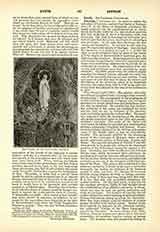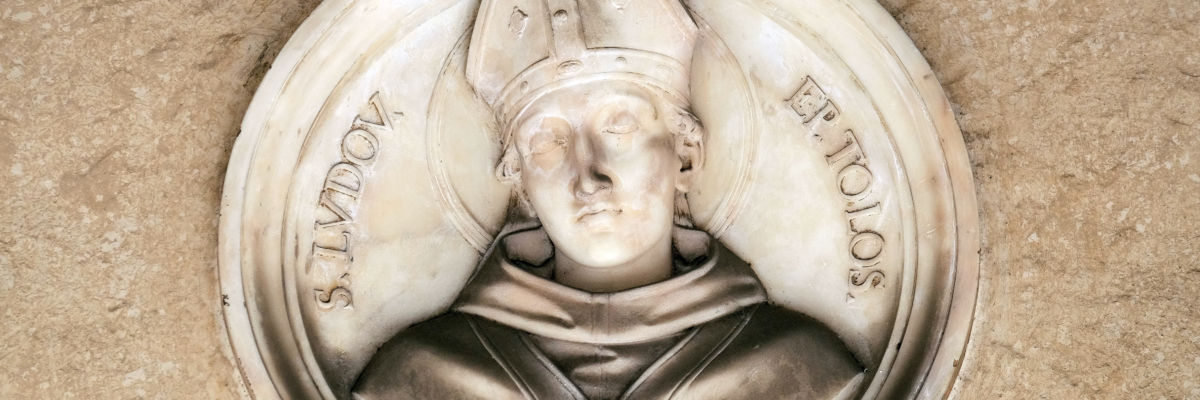

Bishop of Toulouse, generally represented vested in pontifical garments and holding a book and a crosier, b. at Brignoles, Provence, February, 1274; d. there, August 19, 1297. He was the second son of Charles II of Anjou, called the Lame, King of Naples (1288-1309), and nephew of St. Louis IX of France; and of Mary of Hungary whose great-aunt was St. Elizabeth of Hungary. If in some and even early sources (Analecta Franciscana, IV, 310) he is called primogenitus, it is only because he succeeded to the rights of his eldest brother, Charles Martel (d. 1295). In 1288 Louis was sent with two of his brothers to the Kingdom of Aragon as hostage for his father, who had been defeated and captured in a naval battle off Naples by the Sicilians and Aragonians (1284). During the seven years of their captivity (1288-95) in the castle of Sciurana, Diocese of Tarragona, and partly in Barcelona, the education of the three princes was entrusted to some Franciscan friars, among whom were Ponzius Carbonelli (Analecta Franciscana, IV, 310), Peter of Falgar, and Richard of Middleton (Analecta Bollandiana, IX, 295). Peter John Olivi, the great Franciscan Spiritual, was also one of their friends, who on May 18, 1295, wrote them a long letter, published by Ehrle in “Archiv f. Litt. u. Kirchengesch.”, III, 534-40 (see ibid., 439-41). Louis outstripped his brothers both in holiness and learning, and, during a severe illness, made the vow to become a Friar Minor.
He was still in captivity when Celestine V entrusted to him the administration of the Archbishopric of Lyons, on October 7, 1294 (Bullar. Franc., IV 332), having previously granted Francis of Apt, O.F.M., the saint’s confessor, the faculty of giving him the clerical tonsure and minor orders (cf. Bullar. Franc., IV, 332). Neither Bull seems to have been carried out. From John of Orta (Anal. Boll., IX, 292) it appears that he was tonsured only on November 1, 1295, after his release. Louis then returned to Naples. After renouncing all the rights of succession in favor of his brother Robert, he was ordained subdeacon in Rome by Boniface VIII, and in 1296 deacon and priest at Naples (Anal. Boll., IX, 314). Boniface VIII appointed the saintly young priest Bishop of Toulouse, but Louis, wishing first to become a Friar Minor, received the Franciscan habit in Rome from the minister general John Minio of Murro, on December 24, 1296, and immediately made solemn profession. He was consecrated Bishop of Toulouse by Boniface VIIT on 29 (30?) December, 1296 (“Bullar. Franc.”, IV, 422; cf.”Anal. Boll.”, IX, 297). After the Feast of St. Agatha (February 5), 1297, on which day he appeared for the first time publicly in the Franciscan habit, he betook himself to Toulouse, where his mild figure and his virtues were admired by everybody. He was the father of the poor and a model of administration. But his episcopate was very brief, for on his return journey from a visit to his sister, the Queen of Aragon, he was seized by fever and died at Brignoles.
We have scarcely any record of literary work of St. Louis. Recently, however, Amelli, O.S.B., published in the “Archivium Franciscanum Historicum”, II (Quaracchi, 1909), 378-83, a small treatise on music written by the saint, and from this it appears that he is also the author of a “Liber de Musicae Commendatione”. Sbaralea (“Suppl. ad Script.”, Rome, 1806, p. 498) ascribes to him also some sermons. His canonization, promoted by Clement V in 1307 (Bullar. Franc., V, 39), was solemnized by John XXII on April 7, 1317 (loc. cit., 111). His relics reposed in the Franciscan church at Marseilles till 1423, when they were taken by Alfonso V of Aragon to the cathedral church of Valencia, of which town Louis became patron saint. His feast, celebrated in the Franciscan Order on August 19, was decreed by the general chapter held at Marseilles in 1319 (Anal. Franc., III, 473), and the rhythmical office, beginning Tecum, composed by the saint’s brother, King Robert of Naples, was inserted in the Franciscan Breviary by the General Chapter of Marseilles in 1343 (loc. cit., 539), but seems to have been abolished by the Tridentine reform of the Breviary under Pius IV, 1568 (cf. Acta SS., August, III, 805)
LIYARTUS OIIGER


